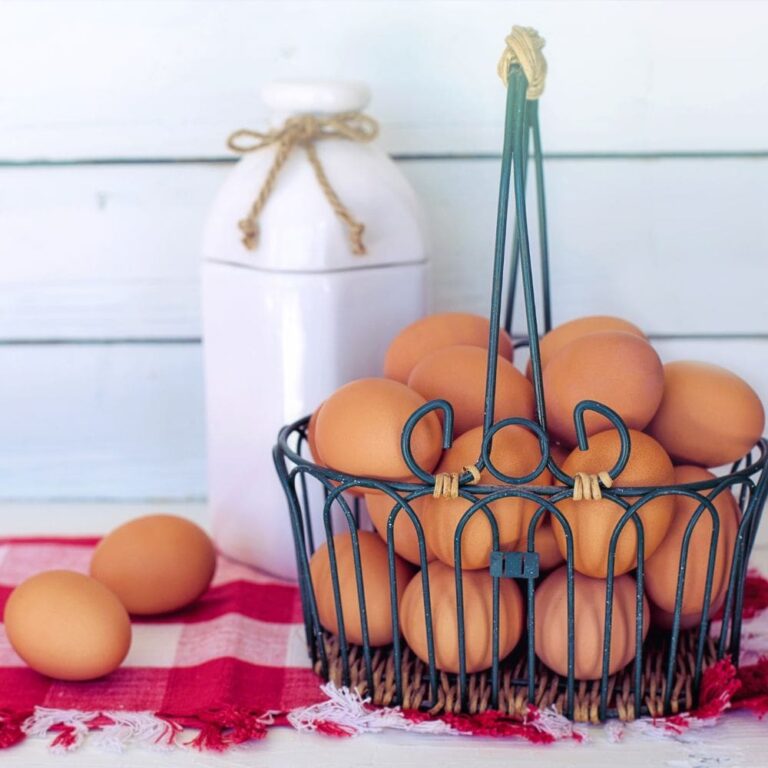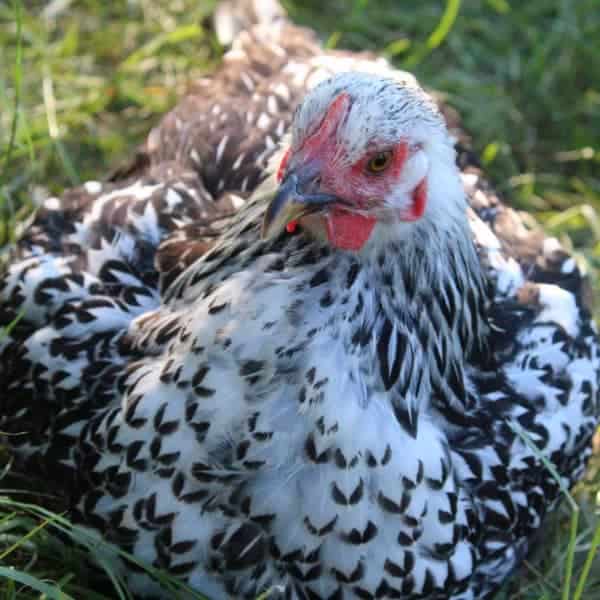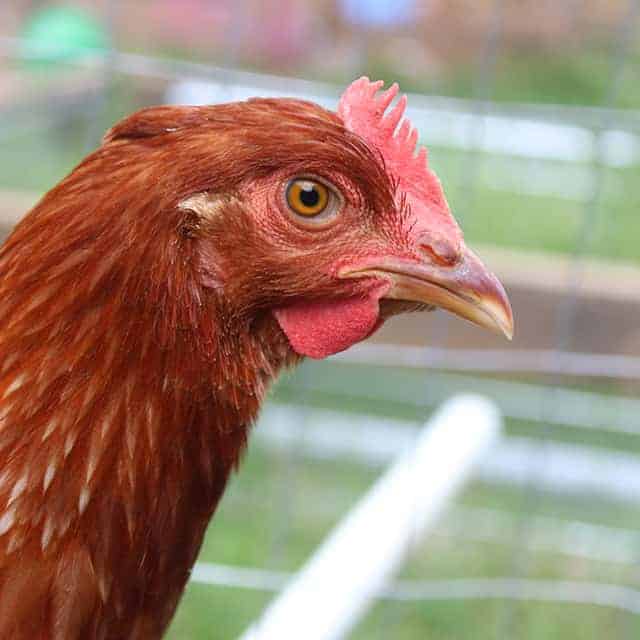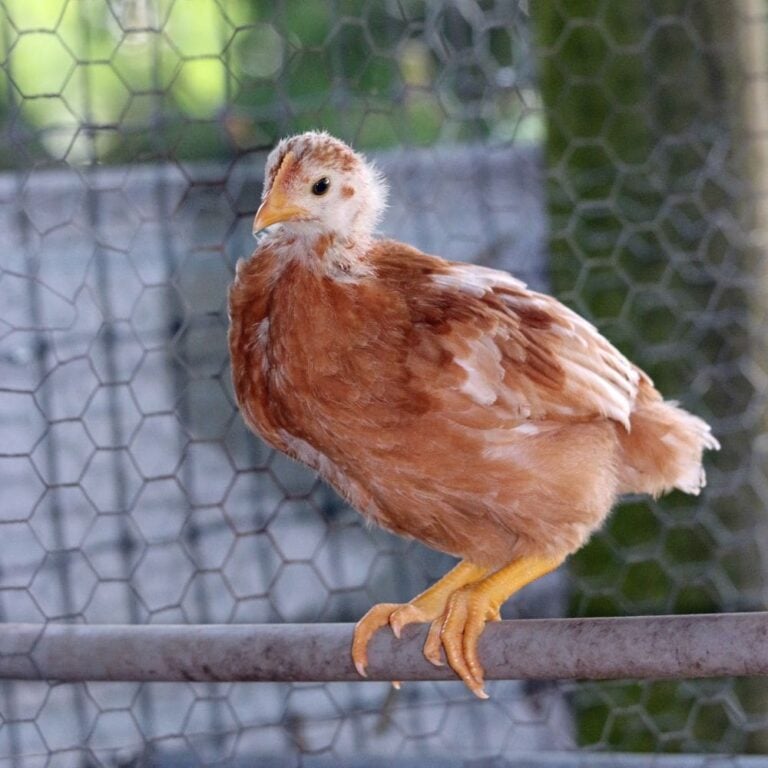What kind of chickens lay blue eggs? If you’ve ever wondered about chickens that lay blue eggs, I’ve got some answers for you!
There are many chicken breeds that lay blue eggs. Let’s take a closer look at chickens that lay blue eggs so you can have those pretty blue eggs in your egg basket this year.
If you’re anything like me, then blue eggs layers are on your “backyard chicken bucket list” this spring.
(Looking for more help raising chickens? Check out my book, Chickens: Naturally Raising A Sustainable Flock!)
Blue eggs are so much fun to have in your morning egg basket, and there are several kinds of chickens that lay blue eggs. Once you’ve got loads of blue eggs in your basket, just make sure you know how long they are good to eat!
And in this podcast, you’ll also discover some breeds that lay green and dark brown eggs, too.

LIKE THIS PODCAST? LISTEN TO THEM ALL HERE
You’ll learn:
- The difference between Araucanas, Ameraucanas, and Easter Eggers
- How eggs get their color (and why all eggs are either blue or white)
- The genetics behind blue eggs
- Which breeds are perfect if you want green eggs
Links we discuss:
Transcript:
Hi there, and welcome to session 23 of What the Cluck?!, a podcast devoted to keeping chickens for fun and self-sufficiency.
I’m Maat from FrugalChicken, and in this episode we’ll talk about different colored eggs and what kind of chickens lay blue eggs in particular.
By the end of this episode, you’ll know about the different chickens you can choose from if you want a colored egg layer, what kind of chickens lay blue eggs, as well as the differences between them.
We’ll also talk about how eggs are colored, just in time for Easter.
This will be a valuable episode that’s also going to be a lot of fun, and full of information about chicken genetics, just to get a little nerdy about things.
Just as a reminder, you can get this episodes show notes at TheFrugalChicken.com/Podcast23, that’s podcast with the numbers 2 and 3.
READ NEXT: 10 ABNORMAL CHICKEN EGGS AND WHAT YOU NEED TO KNOW
So stay with me!
Colored eggs are possibly one of the most fun parts of chicken ownership, and I personally like to keep these kinds of egg layers.
I’ve not had great luck keeping blue egg laying chickens around, so this year, I’m on a mission to really start adding them to my flock.
We’ve done well with green egg layers, and dark brown, obviously since we have the blue copper Marans.
We also have olive egger chickens, and we’ll talk more about what those types of chickens are in a minute.
Marans
So, first, let’s start with the chocolate egg layers, the marans. While when you think of colored layers, marans might not come to mind, their eggs are unique, and fun to add to any backyard flock.
Marans lay brown eggs, and can lay anything from a light brown egg to the coveted chocolate-colored chicken eggs.
Our chickens give us russet brown eggs.
Other people have had different experiences with marans, our chickens don’t lay every day, but other people have chickens that do, so that’s one thing to keep in mind with Marans.
But they’re healthy birds that are great for any flock.
Now, blue egg layers are what a lot of new chicken owners want, so let’s talk about what kind of chickens lay blue eggs!
Chickens that lay blue eggs: Araucanas
Now, any blue egg layer out there will have been derived from the Araucana chicken breed, which carries a blue egg laying gene.
Genetically speaking, there are only chickens that lay white eggs and layers of blue eggs on this planet.
The blue laying gene is a genetic anomaly caused by a retrovirus way back in the evolution of the Araucana breed.
We’ll get more into the specifics of that later in this episode.
But first, let’s talk about Araucanas, and if you’re wondering what kind of chickens lay blue eggs, then this is definitely one of them.
So, these are not to be confused with Ameraucanas, which is a breed we’ll talk about in a minute.
Araucanas are a chicken breed native to Chile, and imported into the US.
For example, Araucanas have tufts of feathers on their head, and are rumpless – both of these genetic traits can be lethal in chick embryos.
This is not unique to Araucana chickens. Crested ducks have a similar set of lethal combinations, if you’ve never seen a crested duck, they have a tuft of feathers on their head, but this because of a genetic skull deformation.
As a result, if two crested ducks are bred together, a proportion of the ducklings will die before hatching and be malformed.
Back to Araucanas, although this is not yet confirmed, Araucanas might be the only chicken breed native to the Americas.
READ NEXT: HOW TO RAISE DUCKLINGS
Chickens that lay blue eggs: Ameraucanas
Next on our list of “What Kind Of Chickens Lay Blue Eggs?” are Ameraucanas.
Ameraucanas are a breed developed in the US based on the Araucana breed.
The name Ameraucana is a mish mash between American and Araucana, so from the outset, the Ameraucana breed was intended to be a separate breed.
The Ameraucana was developed in the United States in the 1970s from Araucana chickens brought from Chile.
It was bred to preserve the blue egg laying gene of the Araucana, but to eliminate the some of the lethal genetics of the Araucana breed.
Ameraucanas were added to the American Poultry Association’s Standard of Perfection in 1984.
So, we have an Ameraucana in our flock, a cute pullet named Hawk, I didn’t pick that name, my husband did, and I can’t wait to get blue eggs from her.
Ameraucanas can lay different shades of blue eggs, making them a lot of fun to raise. (Got abnormal eggs? Learn what to do about abnormal chicken eggs).
Easter Eggers
Another option for colored eggs, including blue, are Easter eggers, and these aren’t to be confused with Araucanas or Ameraucanas.
Easter eggers are not a breed, but rather a hybrid between chickens carrying the blue laying gene and another breed.
We have a few of these on the farm, and because they’re not a true breed, each one is different than the other.
So, if you’re looking for a nice variety of heathy birds that lay colored eggs, then Easter eggers are good option.
It bears mentioning that if you have an Easter Egger, she will only lay one color of eggs, and she won’t lay a different color egg every day.
Unfortunately, none of our Easter eggers lay blue eggs, but one, a pretty gold and black bird I’ve named Cleo, lays pink eggs.
I named her Cleo because she has a dark ring around her eyes, similar to the makeup ancient Egyptians wore, so she reminded me a bit of Cleopatra.
When it comes to chicken names, I’m not overly thoughtful about it, I just pick whatever comes into my head at the time that seems reasonable.
Like I said, because Easter eggers are a cross, there’s no guarantee what color eggs they will lay, nor how they will look, so if you like surprises and varying colors in your morning basket, then Easter Eggers are a great choice for multi colored chicken eggs.
READ NEXT: WHAT CAUSES LASH EGGS AND SALPINGITIS IN CHICKENS?
Olive eggers
So, while Easter Eggers might lay green eggs depending on their genetics, Olive Eggers are ones you can buy that will lay green eggs.
They can lay different shades of green, usually not the pastel green, they usually lay darker green eggs, hence the name Olive Eggers.
They won’t give you blue eggs.
Olive eggers are a cross between a blue egg laying breed, like Ameraucanas, and a dark brown egg laying breed, like Marans, Barnvelders, Welsummers, etc.
Like Easter Eggers, olive eggers aren’t a true breed, but a hybrid. We have a few of these birds, ours are crosses between Ameraucanas and black copper marans.
I’m not going to lie to you, they’re not my favorite chickens out of the flock, even if they lay green eggs.
They’re more skittish than my other breeds, and some of them have a tendency to hide their eggs if given the chance to roam.
At one point, I was getting no eggs from them, only to discover a big nest.
We were in the middle of putting together a new chicken coop for them, and they kept escaping from our main coop. (Check out this long list of FREE chicken coop plans for inspiration!)
Now that our pig has torn a hole in the coop we built for them, they’re all running around again, which is something I’m hoping to fix this weekend.
Their combs differ, because olive eggers can be derived from different breeds, their looks do tend to differ a bit. It makes them more fun, that’s for sure.
Love to SPOIL your flock with chicken treats? (I know you do!) Then quick like a chick, grab your copy of Cluck Cakes! There’s 11 easy recipes for organic and natural treats you can make in your own kitchen! My hens go WILD for them!
Cream Legbars
Now, another option for different colored eggs are Cream Legbars. Now, Legbars can come in different colors, but it’s the Cream Legbar chickens that will potentially lay blue eggs.
Legbars as a breed were created at Cambridge University by cross breeding Barred Plymouth Rocks, Leghorns, and Cambar chickens.
To create the Cream Legbar, which is the only Legbar that lays colored eggs, they also cross bred with Araucanas.
Cream Legbar chicks can be sexed by their down color. The males are lighter in appearance and have a yellow ‘spot’ on the top of his head while and the females have a darker back with darker ‘stripes’.
Why all eggs are either blue or white
So, now let’s talk about how chickens lay different colored eggs and why all eggs are either truly blue or white.
And if you don’t believe me now, you will by the end of this discussion.
Because of genetics, most eggs start off as white when the shell is being developed in the hen. So, why is this?
In most cases, only once the egg hits the uterus, also called the shell gland does it actually become colored.
In the uterus, the actual egg shell is formed, and most of the egg’s time from ovulation until it’s actually laid is spent in the uterus. Read more about the anatomy of an egg.
READ NEXT: WHAT YOUR COOP SHOULD INCLUDE….PLUS MISTAKES TO AVOID
Their final color is based on the chicken’s genetics.
So, with brown and white eggs, their interiors are white, so if you crack them open, you’ll notice the interior of the shell is actually white, despite whatever color the exterior is.
That’s because chickens that lay brown tinted eggs deposit something called porphyrin (poor-phor-in) on the eggs late in the egg shell forming process, usually just a couple hours before laying it.
Because of this, porphyrin does not penetrate the interior of the egg, but colors only the surface of the egg, leaving the interior white.
And in case you’re interested, porphyrin is created by the breakdown of red blood cells.
Now what about green and blue egg layers? If you grab one of those eggs, and break it open, you’ll notice the interior shell is blue, not white.
These chickens use the pigment oocyanin (oh-a-cyanin), a by-product of bile production, to color their egg shells blue.
This pigment is deposited on the egg as it travels through the oviduct, it permeates the egg.
Unlike prophyrin, oocyanin covers eggs with the blue pigment earlier in the shell-making process. With blue egg layers, this results in the interior and exterior of the egg being the same blue color.
Ok, but what about green eggs, you might ask. Well. to create green eggs, the brown pigment overlays a blue shell, which results in a green egg, and a blue interior egg shell.
So, breed genetics aside, how can you tell if your chickens will lay brown, green, blue, or white eggs? Well, look at her ear lobes.
Typically a chicken with white ear lobes will produce white eggs, while those with red earlobes will produce brown or different colored eggs.
So, that’s this week’s podcast, and I hope you’ve enjoyed learning about chicken genetics and maybe it gives you some ideas of breeds to add to your flock this spring.
Now, if you’re new to chickens or maybe you’re an old hand, and want to do something fun, I have a 15 day boot camp coming up called the Healthy Coop Boot Camp.
You can sign up at HealthyCoopBootCamp.com and each day you’ll get an email with a video chock full of information you need to know to raise happy, healthy chickens.
If you’re not sure what to do with chicks when you get them home, or when to switch feeds, or if you’re interested in raising chickens naturally with things like herbs, then my bootcamp is for you.
My Healthy Coop Bootcamp is completely free.
Thanks for listening to this episode of What The Cluck?! about what kind of chickens lay blue eggs, and I’ll see you next time!
READ NEXT: 4 RARE BREEDS OF CHICKENS FOR YOUR HOMESTEAD
I’d like to hear from you!
Did you wonder what kind of chickens lay blue eggs? Are you planning to raise blue egg layers? Do you already own chickens that lay blue eggs?
Leave a comment below!
Chickens; Naturally Raising A Sustainable Flock is my best selling book about raising healthy hens! You’ll learn how to handle sticky first aid situations, raise baby chicks with the week-by-week checklist, how to give the best care even in the worst weather, and more! Click here to learn more.
Maat van Uitert is a backyard chicken and sustainable living expert. She is also the author of Chickens: Naturally Raising A Sustainable Flock, which was a best seller in it’s Amazon category. Maat has been featured on NBC, CBS, AOL Finance, Community Chickens, the Huffington Post, Chickens magazine, Backyard Poultry, and Countryside Magazine. She lives on her farm in Southeast Missouri with her husband, two children, and about a million chickens and ducks. You can follow Maat on Facebook here and Instagram here.










So glad you have this information correct, SO MANY people keep getting the names wrong and misspelled as Americana and stuff like that. You’d think by now that would have been straightened out but people keep getting it wrong.
Thank you for the information. We had no idea about the genetics.